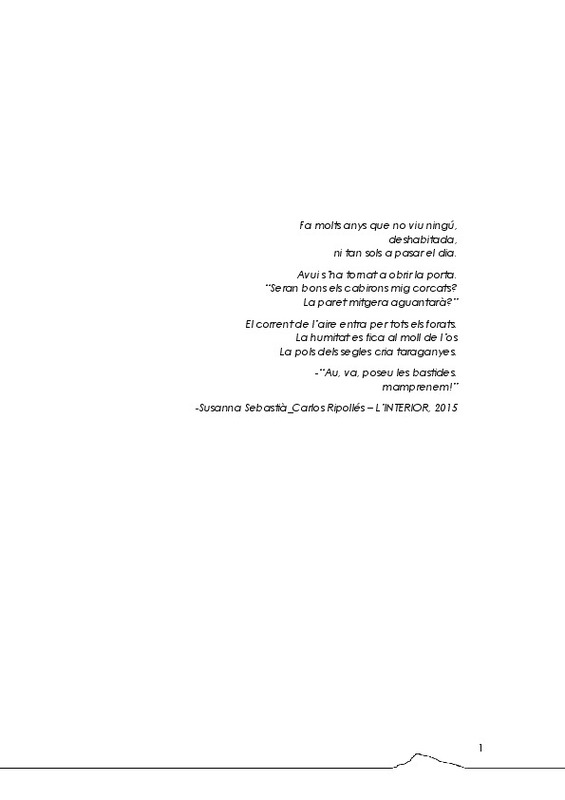JavaScript is disabled for your browser. Some features of this site may not work without it.
Buscar en RiuNet
Listar
Mi cuenta
Estadísticas
Ayuda RiuNet
Admin. UPV
La arquitectura compacta y dispersa relacionada con los itinerarios a Sant Joan de Penyagolosa (Castellón)
Mostrar el registro sencillo del ítem
Ficheros en el ítem
| dc.contributor.advisor | García Esparza, Juan Antonio
|
es_ES |
| dc.contributor.advisor | Tormo Esteve, Santiago
|
es_ES |
| dc.contributor.author | Altaba Tena, Pablo
|
es_ES |
| dc.date.accessioned | 2015-11-30T19:06:36Z | |
| dc.date.available | 2015-11-30T19:06:36Z | |
| dc.date.created | 2015-09 | |
| dc.date.issued | 2015-11-30 | |
| dc.identifier.uri | http://hdl.handle.net/10251/58334 | |
| dc.description.abstract | El presente estudio se centra en analizar la arquitectura compacta y dispersa ligada a los todavía existentes caminos de peregrinación del monte Penyagolosa. El estudio analiza las edificaciones ligadas directamente a estos caminos de peregrinación; desde el núcleo histórico, con casas señoriales, edificios religiosos y fortificados, hasta construcciones rurales dispersas ligadas a oficios extinguidos o en peligro de extinción, como caseríos o masadas, masías, molinos, cenias y neveras. El trabajo explica cómo el proyecto de recuperación de estos caminos de peregrinación ha incentivado la participación ciudadana mediante reuniones vecinales. El artículo expondrá la metodología desarrollada para reconstruir los tramos perdidos del camino de peregrinación y cómo se identifica y relaciona la arquitectura dispersa del siglo XVII, momento de máxima propagación, con las rogativas al Santuario del Penyagolosa. Se exponen pautas sobre la gestión del entorno del Penyagolosa y un capítulo dedicado a la intervención de los elementos existentes. | es_ES |
| dc.description.abstract | The present study is focused on analysing the compact and disperse architecture linked to the still existing pilgrimage routes of Penyagolosa Mountain. The study examines those buildings directly linked to the pilgrimage routes, from the historic centre -stately homes, religious and fortified buildings- until rural disperse constructions related to extinct or endangered crafts -villages, cottages, wineries, mills, wells and caves-. This project explains how the project for the recovery of the pilgrimage pathways has encouraged citizen participation through neighbourhood meetings. The article will present the methodology developed to reconstruct the lost sections of the paths and how the scattered architecture of the 17th Century, when its maximum spread, is identified and related to the religious devotion to the shrine of Penyagolosa. The investigation explains guidelines about the management of Penyagolosa environment and a section to the intervention of the existing elements. | es_ES |
| dc.format.extent | 154 | es_ES |
| dc.language | Español | es_ES |
| dc.publisher | Universitat Politècnica de València | es_ES |
| dc.rights | Reconocimiento - No comercial - Sin obra derivada (by-nc-nd) | es_ES |
| dc.subject | Itinerarios culturales | es_ES |
| dc.subject | Rutas culturales | es_ES |
| dc.subject | Arquitectura vernácula | es_ES |
| dc.subject | Patrimonio cultural | es_ES |
| dc.subject | Patrimonio arquitectónico | es_ES |
| dc.subject | Cultural routes | es_ES |
| dc.subject | Vernacular architecture | es_ES |
| dc.subject | Cultural heritage | es_ES |
| dc.subject | Architectural heritage | es_ES |
| dc.subject | Sant Joan de Penyagolosa (Vistabella del Maestrazgo, Castellón) | es_ES |
| dc.subject | San Juan de Peñagolosa (Vistabella del Maestrazgo, Castellón) | es_ES |
| dc.subject.classification | CONSTRUCCIONES ARQUITECTONICAS | es_ES |
| dc.subject.other | Máster Universitario en Conservación del Patrimonio Arquitectónico-Màster Universitari en Conservació del Patrimoni Arquitectònic | es_ES |
| dc.title | La arquitectura compacta y dispersa relacionada con los itinerarios a Sant Joan de Penyagolosa (Castellón) | es_ES |
| dc.type | Tesis de máster | es_ES |
| dc.rights.accessRights | Abierto | es_ES |
| dc.description.bibliographicCitation | Altaba Tena, P. (2015). La arquitectura compacta y dispersa relacionada con los itinerarios a Sant Joan de Penyagolosa (Castellón). http://hdl.handle.net/10251/58334. | es_ES |
| dc.description.accrualMethod | Archivo delegado | es_ES |
Este ítem aparece en la(s) siguiente(s) colección(ones)
-
ETSA - Trabajos académicos [4687]
Escuela Técnica Superior de Arquitectura






